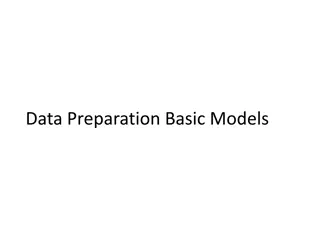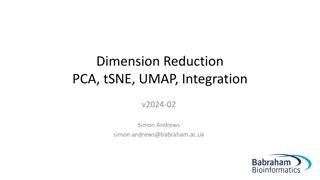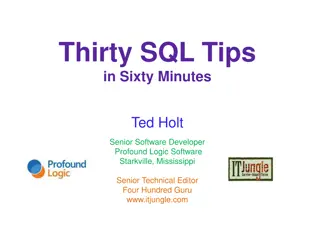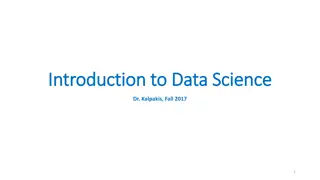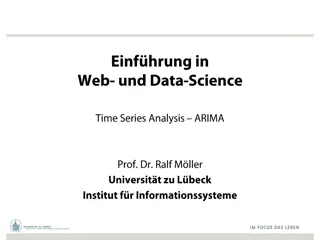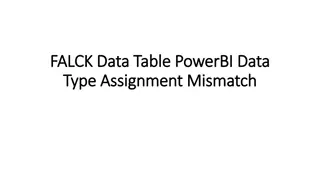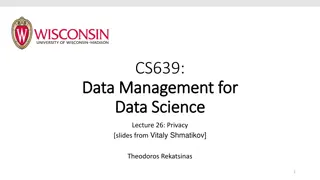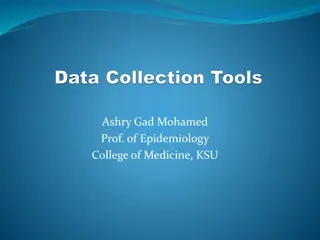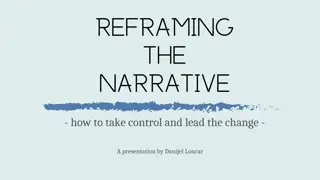Understanding Data Reshaping Techniques in R
Learn how to reshape data effectively using R, including the concepts of long and wide formats, practical examples, and the use of packages like tidyr and reshape2. Explore converting data from long to wide formats, handling measured variables, and transitioning back to long format seamlessly.
Download Presentation

Please find below an Image/Link to download the presentation.
The content on the website is provided AS IS for your information and personal use only. It may not be sold, licensed, or shared on other websites without obtaining consent from the author. Download presentation by click this link. If you encounter any issues during the download, it is possible that the publisher has removed the file from their server.
E N D
Presentation Transcript
Reshaping data using R James Gwinnutt
Outline What is reshaping How to do it in R
Reshaping There are two ways to store clustered data (e.g. longitudinal data, hierarchical data) Long Wide Example
Reshaping Baseline 6 hours 12 hours 001 001 001 38.1 37.6 38.3
Long ID Time (hours) Temperature (degrees) 001 0 38.3 001 6 38.1 001 12 37.6 Wide ID Temperature_0 Temperature_6 Temperature_12 001 38.3 38.1 37.6
Reshape in R Two packages to do this tidyr pivot_longer & pivot_wider (formerly gather and spread) reshape2 melt and cast
Example dataset Blood pressure data 120 people Blood pressure data, before and after an intervention bplong <- foreign::read.dta('https://www.stata-press.com/data/r8/bplong.dta')
Tidyr pivot_wider to convert the data from long to wide format bpwide <- bplong %>% pivot_wider(names_from = 'when', values_from = 'bp') New (wide) dataframe Follow-up variable name Measured variable(s) Function Original (long) dataframe
2 measured variables? New variable bplong$test <- bplong$bp + 1000 bpwide2 <- bplong %>% pivot_wider(names_from = 'when', values_from = c(bp, test)) Use c() to make a list of variables
Back to long pivot_longer to convert data from wide to long
Back to long pivot_longer to convert data from wide to long bplong2 <- bpwide %>% pivot_longer(c(Before, After), names_to = 'timepoint', values_to = 'bp') New (long) dataframe New variable denoting the timepoint Function New name for measured variable Variables to convert from wide to long Original (wide) dataframe
Pivot all variables except these Multiple variables New variable names bplong3 <- bpwide2 %>% pivot_longer(cols = -c(patient, sex, agegrp), names_to = c(".value", "timepoint"), names_pattern = "([A-Za-z]+)_([A-Za-z]+)") Variable naming pattern
reshape2 First melt the dataframe molten <- melt(bplong, measure.vars = 'bp')
reshape2 Then cast it to desired shape bpwide <- dcast(molten, patient + sex + agegrp ~ when)
Multiple variables bplong$test <- bplong$bp + 1000 molten2 <- melt(bplong, measure.vars = c('bp', 'test'))
Multiple variables bpwide2 <- dcast(molten2, patient + sex + agegrp ~ variable + when)
Reshape2 wide to long bplong2 <- melt(bpwide, id.vars = c("patient", "sex", "agegrp"))
Multiple variables bplong3 <- melt(bpwide2, id.vars = c("patient", "sex", "agegrp")) Not very satisfying
library(splitstackshape) bplong3 <- merged.stack(bpwide2, id.vars = c("patient", "sex", "agegrp"), var.stubs = c("bp", "test"), sep = "_")
Learn more here David s page: https://personalpages.manchester.ac.uk/staff/david.selby/stata/2021- 02-02-refinements/#reshaping-data






